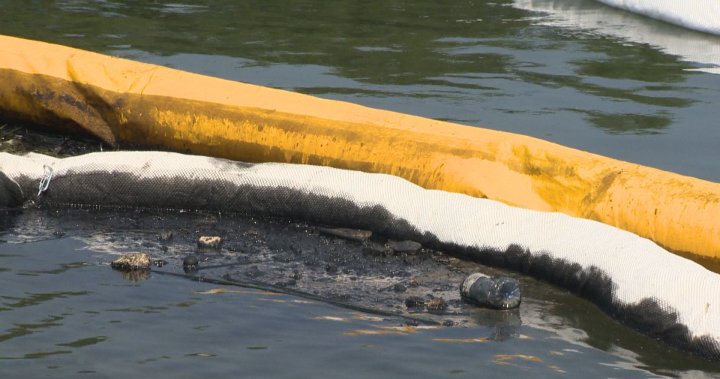Another oil contamination has been detected in the St. Lawrence River in Pointe-aux-Trembles, prompting an investigation by the province’s Environment Ministry. This comes just a week after a cleanup of a previous spill in the same area was completed. The oil contamination, detected at the marina after heavy rains, has been identified to have the same profile as the spill on July 11. Environmentalists like Norman Beaudet are concerned about the amount of oil-related activities in the area, such as oil refineries and boating, which could contribute to further contamination issues.
The Canadian Coast Guard has confirmed that the oil came from a stormwater pipe draining into the river. However, Beaudet and his group remain worried as the source of the contamination could be anywhere. For example, old contaminated sites that become saturated during heavy rains could drain into the sewage system, posing a challenge in locating the exact source of the contamination. The Environment Ministry has implemented mitigation measures and is working with the City of Montreal to identify the origin of the spill in the system. Beaudet suggests checking other sewage system drainage points to pinpoint the specific area responsible for the contamination.
Access to the marina has been restricted to boat owners, and boats are not allowed to leave until they are cleaned to prevent further spread of contamination. The ministry has assured that there is no reason to believe that drinking water has been affected by the spill. Beaudet emphasizes the importance of limiting the damage to wildlife by containing the spill within the marina area. The ongoing investigation aims to identify any additional sources of contamination and prevent further oil spills in the St. Lawrence River. The collaboration between environmentalists, government agencies, and local authorities is crucial in addressing the issue effectively.
The concentration of oil-related activities in Pointe-aux-Trembles poses a significant risk of contamination in the St. Lawrence River. Beaudet points out that the industrial area of Pointe-aux-Trembles is surrounded by the sewage system, which could potentially contribute to the spread of contaminants into the river. The need to identify and address the sources of contamination is crucial in preventing future spills and protecting the ecosystem of the St. Lawrence River. Efforts to monitor and control oil-related activities in the area are necessary to mitigate the environmental impact and ensure the safety of the waterways.
Environmentalists like Beaudet emphasize the importance of proactive measures to prevent oil spills and contamination in sensitive water bodies like the St. Lawrence River. The need for stricter regulations and monitoring of industrial activities in areas with high oil-related activities is essential to prevent further environmental damage. Collaborative efforts between government agencies, environmental groups, and local authorities are crucial in addressing contamination issues and ensuring the protection of aquatic ecosystems. By identifying sources of contamination, implementing mitigation measures, and conducting regular monitoring, the risks of oil spills in the St. Lawrence River can be minimized, safeguarding the health of the river and its surrounding environment for future generations.


